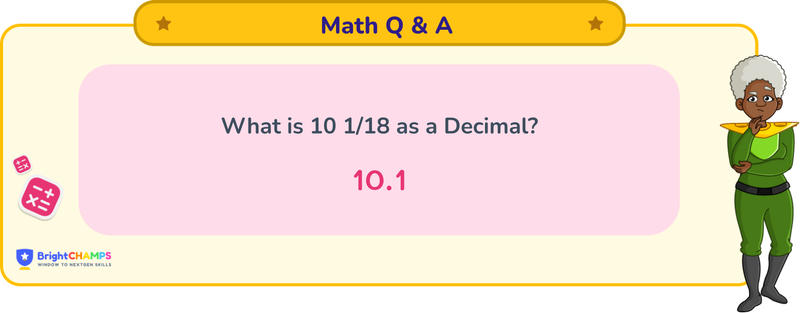
 159 Learners
159 LearnersLast updated on May 26th, 2025

10 1/18 as a Decimal

It is a simple question on decimal conversion. Firstly, we have to understand mixed numbers and decimals. A mixed number represents a whole number and a fraction combined. It has two parts: a whole number and a fraction. A fraction itself has a numerator (the number on the top) and a denominator (the number below). A decimal is a way to represent a number that is not whole, using a decimal point (.) to separate the whole part from the fractional part. The numbers to the left of the decimal point represent the whole, and those to the right represent the fractional part.
What is 10 1/18 as a decimal?

Answer
10 1/18 in decimals can be written as approximately 10.0556.
Explanation
To convert 10 1/18 to a decimal, we will first convert the fraction 1/18 into a decimal and then add it to the whole number 10. Let's see the step-by-step breakdown of the process:
Step 1: Identify the mixed number components, where 10 is the whole number and 1/18 is the fractional part.
Step 2: Convert the fraction 1/18 to a decimal by dividing the numerator (1) by the denominator (18).
Step 3: 1 divided by 18 gives approximately 0.0556 (rounded to four decimal places).
Step 4: Add this decimal value to the whole number 10.
Step 5: The result is 10 + 0.0556 = 10.0556.
Hence, the decimal representation of 10 1/18 is approximately 10.0556.
Struggling with Math?
Get 1:1 Coaching to Boost Grades Fast !

Important Glossaries for 10 1/18 as a decimal
- Mixed Number: A number consisting of a whole number and a fraction.
- Fraction: A numerical quantity that is not a whole number, representing a part of a whole.
- Decimal: A number that uses the base ten and includes a decimal point to separate the whole part from the fractional part.
- Numerator: The top part of a fraction, indicating how many parts of the whole are being considered.
- Denominator: The bottom part of a fraction, showing how many parts make up a whole.




